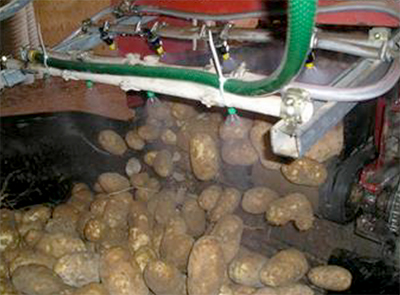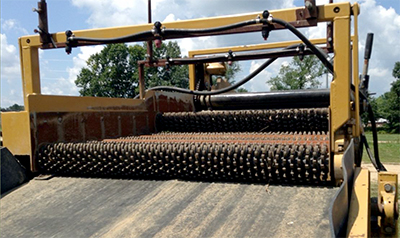Guidelines for applying Stadium to potato tubers
Achieve optimum coverage with Stadium on potato tubers entering storage by following these guidelines.

Potatoes are susceptible to a variety of storage pathogens, including Fusarium dry rot (Fusarium sambucinum), silver scurf (Helminthosporium solani), late blight (Phytophthora infestans), Pink rot (Phytophthora erythroseptica), Pythium leak (Pythium ultimum) and black dot (Colletotrichum coccodes). Current recommendations for potato storage diseases include sanitation and exclusion as the primary controls for these pathogens in storage facilities. Few fungicides are registered for direct application to tubers for control of these important pathogens and few compounds are available for potato tuber treatment in storage, including chlorine-based disinfectants such as sodium hypochlorite, calcium hypochlorite and chlorine dioxide.
Several commercial storage products, like Phostrol (sodium, potassium and ammonium phosphates) and Storox (hydrogen peroxide/peroaxyacetic acid mixture), are registered for control of storage pathogens. Recently, Stadium, a new product from Syngenta Crop Protection was registered for use as a pre-storage treatment for management of Fusarium dry rot and silver scurf in storage. Stadium is a three-way mixture of azoxystrobin (Quadris), fludioxonil (Maxim) and difenoconazole (Inspire) and the application rate is 1.0 fluid ounces per 20 cwt (ton) of potato tubers carried in 0.5 gallon H2O per ton of tubers. Results from trials at Michigan State University and the University of Idaho show that Stadium provided effective disease control.
How to achieve optimum coverage with Stadium on potato tubers entering storage
Key points
- Ensure consistent uniform spray coverage of tubers.
- Position the spray nozzles at a point where tubers are rotating, turning or dropping during the application.
- Be sure the proper spray volume will allow full coverage without leaving the tubers dripping wet.
- Check calibration regularly during application.
- Constant agitation of spray liquid is required to maintain product in suspension.
Evaluate the treatment system
Storage facilities, storage processes and storage conveyer systems can vary greatly as to setup, volume and quality of the crop being stored. Before application, it is important to evaluate each location and design an application system to meet the needs of the specific conditions.
- Configuration of unloading, sorting conveyor systems: is there adequate space available for the application?
- Note positions along the line where a spray may be applied to the tubers (e.g., drop points, spread points, room for a spray table along the line).
- Tonnage per hour being stored: this will dictate the type and volume of the application system.
Position
The treatment site should be easily accessible to allow calibration, inspecting spray and coverage, and for cleaning nozzles and maintenance. The treatment site should be at a point where tubers are rotating, turning or dropping to insure coverage.
Spray volume
Strive to achieve optimum spray volume for each storage facility:
- Too high of a carrier volume will leave the tubers wet and encourage bacterial rot.
- Too low or a carrier volume will prohibit adequate coverage and limit protection.
- Tubers should look uniformly “damp” but not “dripping wet.”
- Use 0.25 to 0.5 gallons per ton
- Note - The target volume (spray per ton of tubers) can vary with tuber size. Smaller tubers have more surface area and may require slightly more carrier volume per ton.
Tonnage
For high tonnage systems, resulting in multiple layers of tubers on conveyers, a “drop” application method is appropriate. For lower tonnage, or single layer of tubers, roller tables or conveyors may be considered. If tonnage and space allow, roller tables or toll-booth application positions, where multiple layers of tubers are allowed to spread out into a single layer, may be appropriate. Where space does not allow for roller tables, positioning nozzles at a logical drop point is probably the best option.
Type of application system
The objective of tuber application is to apply Stadium uniformly across the surface of the tuber in adequate carrier volume to ensure good coverage, but without leaving the tubers visibly “wet.” Two primary configurations exist: application table application and drop-point application.
Application table application
- If space allows, a roller-application table or roller-toll-booth-spreading system can be used for application. This would ideally be positioned just after the final sorting tables.
- Shielding is required to reduce exposure close to the sorting workers.
- Rollers are required to ensure that tubers are rotating or turning during application.
- If the tubers are in a single layer, a roller table is appropriate.
- If the tubers are typically two-deep or more, a spreading system may be required to reduce their depth to a single layer.
- Nozzles are positioned above the line to spray down onto the rotating tubers.
 Drop-point application
Drop-point application
- If space or other considerations do not allow for a roller table application, a drop-point application may be used.
- The spray is applied to tubers as they fall from one conveyor to another, or off the end of the piler.
- Chose a natural drop-point where tubers fall in a single layer and where nozzles can be positioned for best coverage.
- Note that for high tonnage operations where falling tubers remain in multiple layers, nozzles must be positioned both above and below the falling tubers.
- If conveyor-to-conveyor drop points are shielded, or where tubers “flow” several tuber deep from one conveyor to another, then the only choice may be to position the sprayer at the end of the piler. This is not ideal and certain factors should be recognized: it will be difficult to inspect, clean and maintain such a system, and the risk of pile contamination or over application exists, in case of breakage or a system blow-out.
Recommended spray location
 Michigan State University Extension recommends that Stadium be applied at each drop at the end of a star-roller system, before dropping to the conveyor system into the storage facility. The tubers will be cleaned as much as possible and will still be spread out in a thin layer prior to hitting the conveyor. Two spray bars approximately 2 feet apart will ensure best coverage.
Michigan State University Extension recommends that Stadium be applied at each drop at the end of a star-roller system, before dropping to the conveyor system into the storage facility. The tubers will be cleaned as much as possible and will still be spread out in a thin layer prior to hitting the conveyor. Two spray bars approximately 2 feet apart will ensure best coverage.
Mixing and calibration
Once setup, tonnage and application volume has been determined, proper calibration is critical.
- Measure the tonnage throughput per hour.
- Calculate the spray volume per minute required to apply the volume per ton of tubers. For example: 7.5 gallons per hour for 0.5 gallons per ton.
- Measure and verify that the spray application system can deliver the amount required per minute or that it can be adjusted if necessary.
Calibration example (Note that gallons sprayed per hour should be the sum of the volumes from all nozzles delivered per hour):
Higher tonnage per hour
- Target tons per hour = 30 (0.5 tons per minute)
- Gallons per ton = 0.5
- Gallons sprayed per hour = 15 (0.25 gallons sprayed per minute)
- (30 tons per hour x 0.5 gallons per hour)
Lower tonnage per hour
- Target tons per hour = 15 (0.25 tons per minute)
- Gallons per ton = 0.5
- Gallons sprayed per hour = 15 (0.25 gallons sprayed per minute)
- (15 tons per hour x 0.5 gallons per hour)
General guidelines and considerations
- Always follow label instructions.
- Read the label in its entirety.
- Instruct and demonstrate the label to all people mixing, handling or applying Stadium fungicide.
- Constant agitation of the slurry is important during the application process.
- Does the operator or facility have appropriate certifications?
- Where will the treatment area be situated relative to the pile and workers?
- All treatment areas should be enclosed or shielded where possible, or otherwise setup to prevent drift of spray mist.
- Check calibration regularly to insure proper dosage delivery.
- Application volumes must be adjusted to the capacity of the line and tuber volume being treated.
- Position drip trays below the treatment site to catch waste chemical.
- Does the application system have an automatic cut-off to stop the applicator if tuber flow ceases?
- It should be possible to stop all machinery on the line via one switch in case of emergency.
- What is the anticipated throughput in tons per hour?
- Can a constant throughput be maintained?
- Can all parts of the line handle the throughput?
- Can any treatment table be consistently filled across its width?
- Will the applicator deliver the desired output and maintain an effective spray pattern?
- If a conveyor, elevator or piler application system is used, is the “drop” great enough to achieve coverage while small enough to minimize damage?
Dr. Kirk’s work is funded in part by MSU’s AgBioResearch.



 Print
Print Email
Email



